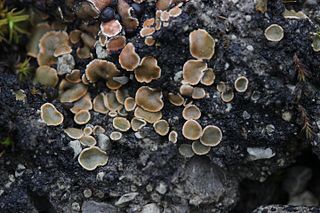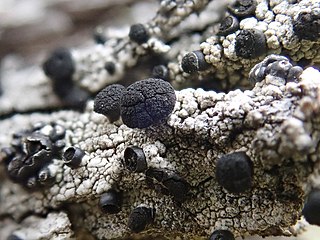
Psora is a genus of lichen-forming fungi in the family Psoraceae. Members of the genus are commonly called fishscale lichens. Lichens in the genus Psora generally have a squamulose thallus and anthraquinones in the hymenium. Photobiont partners of Psora lichens include members of the green algal genera Asterochloris, Chloroidium, Myrmecia, and Trebouxia.

Porina is a genus of crustose lichens in the family Trichotheliaceae. As of August 2024, Species Fungorum accepts 161 species of Porina.

Diploschistes is a genus of lichen-forming fungi in the family Graphidaceae. Commonly known as crater lichens, members of the genus are crustose lichens with a thick, cracked (areolate) body (thallus) with worldwide distribution. The fruiting part (apothecia) are immersed in the thick thallus so as to have the appearance of being small "craters". The widespread genus contains about 43 species.

Acolium is a genus of lichenized fungi in the family Caliciaceae. The genus has a widespread distribution and contains six species. These lichens are found on bark and wood, occasionally on rocks, or growing on other lichens.

Immersaria is a genus of lichen-forming fungi in the family Lecideaceae. It has eight species of crustose lichens.
Teuvoa is a genus of lichen-forming fungi in the family Megasporaceae. It was first classified by lichenologists Mohammad Sohrabi and Steven Leavitt in 2013, with Teuvoa uxoris assigned as the type species. This genus was delineated from the larger genus, Aspicilia, following a molecular phylogenetic analysis which revealed that the Aspicilia uxoris species group constituted a distinct lineage in the Megasporaceae. Initially containing three species, two additional species native to China were added in 2018. Teuvoa is characterised by its small ascospores and conidia, and the absence of secondary metabolites.

Lathagrium is a genus of lichen-forming fungi in the family Collemataceae. It has 10 species of gelatinous lichens. Species in this genus typically grow on calcareous rocks, often amidst mosses, but can also be found on siliceous or serpentine rocks, mortar, or soil.
Asterothyrium vezdae is a species of foliicolous (leaf-dwelling) lichen in the family Gomphillaceae. It is found in Bolivia, where it grows on the leaves of vascular plants in the Amazon rainforest. The lichen is distinguished from its closest relative, Asterothyrium octomerum, by the larger number of septa in its ascospores, and its and black apothecia.
Placolecis kunmingensis is a species of saxicolous (rock-dwelling), crustose lichen in the family Catillariaceae. It is found in Yunnan, China. The lichen is characterised by a thallus that is areolate to squamulose in its centre, forming irregular patches or clumps 10–50 mm wide, as well as its ellipsoid or spherical ascospores with slightly thickened wall.
Tetramelas flindersianus is a saxicolous (rock-dwelling) crustose lichen species in the family Physciaceae. First described scientifically in 2020, it is found in Australia.
Tetramelas gariwerdensis is a species of saxicolous (rock-dwelling), crustose lichen in the family Physciaceae, described in 2020. It is found in the Grampian Mountains in western Victoria, Australia.
Buellia cravenii is a species of saxicolous (rock-dwelling), crustose lichen in the family Caliciaceae. It is found in Australia. The lichen spreads up to 3.5 cm wide thick, forming a continuous, grey-white cracked pattern of areoles.
Buellia kowenensis is a rare species of saxicolous (rock-dwelling), crustose lichen in the family Caliciaceae. It is only known to occur at its original collection site in the Australian Capital Territory of Australia.
Buellia lordhowensis is a little-known saxicolous (rock-dwelling), crustose lichen species in the family Caliciaceae, first described in 2020. It is only known to occur on Lord Howe Island, Australia.
Buellia phillipensis is a little-known species of saxicolous (rock-dwelling), crustose lichen in the family Caliciaceae, described in 2020. It is only known to occur on Phillip Island in the Southwest Pacific.
Amandinea pilbarensis is a little-known species of crustose lichen in the family Physciaceae, First described in 2020, it is found in Australia. It is similar to Amandinea polyxanthonica, but can be distinguished by its smaller ascospores and the presence of calcium oxalate and thiophanic acid in the medulla.
Buellia subalbula is a species of saxicolous (rock-dwelling), crustose lichen in the family Caliciaceae. It occurs in coastal southern Africa, South America, and Australia, where it grows on calcareous rocks.
Austroparmeliella is a genus of lichen-forming fungi in the family Pannariaceae. It consists of five species, all of which are found in the Southern Hemisphere.
Ramboldia gowardiana is a species of corticolous (bark-dwelling), crustose lichen in the family Ramboldiaceae. First discovered in 2003 in Montana, United States, it typically appears as a grayish or greenish crust on tree bark, particularly on conifers like pines and firs. The lichen is characterised by its small, bright red to orange-red reproductive structures (apothecia) visible on its surface. R. gowardiana is found in dry, temperate forests from Alaska to California, often at elevations between 300 and 1,400 meters. Initially classified in a different genus, it was reclassified as Ramboldia in 2008 based on genetic studies. This lichen is part of the biodiversity of the Pacific Northwest region of North America.

Aspilidea is a fungal genus of uncertain familial placement in the subclass Ostropomycetidae. It contains the single species Aspilidea myrinii, a saxicolous (rock-dwelling) crustose lichen with a circumpolar distribution.











